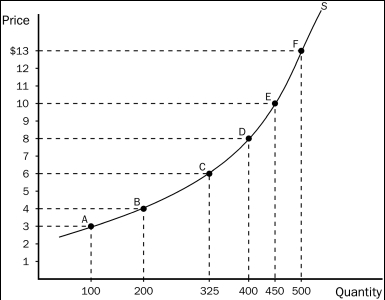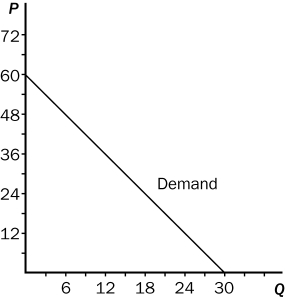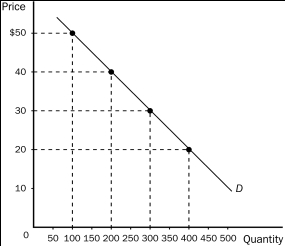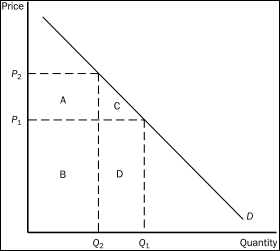A) Very small changes in price lead to very large changes in quantity supplied.
B) Very large changes in price lead to very small changes in quantity supplied.
C) Very small changes in price lead to no change in quantity supplied.
D) Very large changes in price lead to no change in quantity supplied.
Correct Answer

verified
Correct Answer
verified
Multiple Choice
Figure 5-12
 -Refer to Figure 5-12.Along which of these segments of the supply curve is supply most elastic?
-Refer to Figure 5-12.Along which of these segments of the supply curve is supply most elastic?
A) between A and B
B) between C and D
C) between D and F
D) between E and F
Correct Answer

verified
Correct Answer
verified
Multiple Choice
If the quantity demanded of a certain good responds only slightly to a change in the price of the good,then
A) the demand for the good is said to be elastic.
B) the demand for the good is said to be inelastic.
C) the law of demand does not apply to the good.
D) the demand curve for the good shifts only slightly in response to a change in price.
Correct Answer

verified
Correct Answer
verified
Multiple Choice
If the price elasticity of demand for a good is 4.0,then a 10 percent increase in price results in a
A) 0.4 percent decrease in the quantity demanded.
B) 2.5 percent decrease in the quantity demanded.
C) 4 percent decrease in the quantity demanded.
D) 40 percent decrease in the quantity demanded.
Correct Answer

verified
Correct Answer
verified
Multiple Choice
The supply of a good will be more elastic,the
A) more the good is considered a luxury.
B) broader is the definition of the market for the good.
C) larger the number of close substitutes for the good.
D) longer the time period being considered.
Correct Answer

verified
Correct Answer
verified
Multiple Choice
A perfectly elastic demand implies that
A) buyers will not respond to any change in price.
B) any rise in price above that represented by the demand curve will result in a quantity demanded of zero.
C) quantity demanded and price change by the same percent as we move along the demand curve.
D) price will rise by an infinite amount when there is a change in quantity demanded.
Correct Answer

verified
Correct Answer
verified
Multiple Choice
A key determinant of the price elasticity of supply is
A) the ability of sellers to change the price of the good they produce.
B) the ability of sellers to change the amount of the good they produce.
C) how responsive buyers are to changes in sellers' prices.
D) the slope of the demand curve.
Correct Answer

verified
Correct Answer
verified
True/False
Necessities tend to have inelastic demands,whereas luxuries have elastic demands.
Correct Answer

verified
Correct Answer
verified
Multiple Choice
In the long run,the quantity supplied of most goods
A) will increase in almost all cases, regardless of what happens to price.
B) cannot respond at all to a change in price.
C) can respond to a change in price, but the change is almost always inconsequential.
D) can respond substantially to a change in price.
Correct Answer

verified
Correct Answer
verified
Multiple Choice
Using the midpoint method,the price elasticity of demand for a good is computed to be approximately 0.78.Which of the following events is consistent with a 4.68 percent decrease in the quantity of the good demanded?
A) a 3.65 increase in the price of the good
B) a 16.67 percent increase in the price of the good
C) an increase in the price of the good from $48.00 to $50.97
D) an increase in the price of the good from $65.00 to $66.98
Correct Answer

verified
Correct Answer
verified
Multiple Choice
Figure 5-8. A demand curve is shown on the graph below. On the graph, Q represents quantity demanded and P represents price.
 -Refer to Figure 5-8.At a price of $48 per unit,sellers' total revenue amounts to
-Refer to Figure 5-8.At a price of $48 per unit,sellers' total revenue amounts to
A) $150.
B) $200.
C) $288.
D) $364.
Correct Answer

verified
Correct Answer
verified
Multiple Choice
Demand is said to have unit elasticity if elasticity is
A) less than 1.
B) greater than 1.
C) equal to 1.
D) equal to 0.
Correct Answer

verified
Correct Answer
verified
Multiple Choice
Demand is said to be elastic if
A) the price of the good responds substantially to changes in demand.
B) demand shifts substantially when income or the expected future price of the good changes.
C) buyers do not respond much to changes in the price of the good.
D) buyers respond substantially to changes in the price of the good.
Correct Answer

verified
Correct Answer
verified
True/False
Price elasticity of demand along a linear,downward-sloping demand curve increases as price falls.
Correct Answer

verified
Correct Answer
verified
Multiple Choice
Figure 5-5
 -Refer to Figure 5-5.An increase in price from $30 to $35 would
-Refer to Figure 5-5.An increase in price from $30 to $35 would
A) increase total revenue by $250
B) decrease total revenue by $250.
C) increase total revenue by $500.
D) decrease total revenue by $500.
Correct Answer

verified
Correct Answer
verified
Multiple Choice
According to a Los Angeles Times article published in May 2005,recent estimates indicate that
A) the short-run and long-run price elasticities of demand for gasoline are 0.1 and 0.5, respectively.
B) the short-run and long-run price elasticities of demand for gasoline are 0.1 and 1.0, respectively.
C) the short-run and long-run price elasticities of demand for gasoline are 0.2 and 1.5, respectively.
D) the short-run and long-run price elasticities of demand for gasoline are 0.5 and 1.5, respectively.
Correct Answer

verified
Correct Answer
verified
Multiple Choice
The price elasticity of demand for bread
A) is computed as the percentage change in quantity demanded of bread divided by the percentage change in price of bread.
B) depends, in part, on the availability of close substitutes for bread.
C) reflects the many economic, social, and psychological forces that influence consumers' tastes for bread.
D) All of the above are correct.
Correct Answer

verified
Correct Answer
verified
True/False
Supply tends to be more elastic in the short run and more inelastic in the long run.
Correct Answer

verified
Correct Answer
verified
Multiple Choice
Figure 5-7
 -Refer to Figure 5-7.Total revenue when the price is P₂ is represented by the area(s)
-Refer to Figure 5-7.Total revenue when the price is P₂ is represented by the area(s)
A) B + D.
B) A + B.
C) C + D.
D) D.
Correct Answer

verified
Correct Answer
verified
Multiple Choice
For a good that is a luxury,demand
A) tends to be inelastic.
B) tends to be elastic.
C) has unit elasticity.
D) cannot be represented by a demand curve in the usual way.
Correct Answer

verified
Correct Answer
verified
Showing 201 - 220 of 282
Related Exams